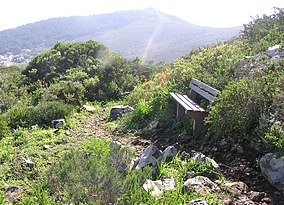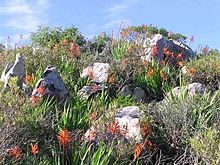Tygerberg Nature Reserve
| Tygerberg Nature Reserve | |
|---|---|
 Tygerberg Nature Reserve | |
Map of the City of Cape Town | |
| Location | Bellville, South Africa |
| Coordinates | 33°52′42″S 18°35′50″E / 33.8783°S 18.5972°E |
| Area | 300 ha (740 acres) |
| Established | 1973 |
| City of Cape Town Nature Reserves | |

Tygerberg Nature Reserve is a 300-hectare (740-acre) nature reserve on the Tygerberg Hills, Bellville, Western Cape in the northern suburbs of Cape Town, South Africa.
This nature reserve one of the few surviving pockets of the highly threatened Swartland Shale Renosterveld vegetation type.[1] The 300 ha reserve has an exceptional number of species. There are nearly five hundred different plant species here, twelve of which are threatened with extinction and eight of which exist only in Cape Town. Three of the plant species of Tygerberg exist only within the boundaries of the reserve itself. In addition, there are over a hundred bird species and a variety of wild mammals such as honey badger, roaming leopard, pipe squirrels and wall snakes, reptiles and amphibians are also common. The Plattekloof Dam is located just west of the hills, and is being restored to a natural wetland. The park hosts the Kristo Pienaar Environmental Education Centre with its library and resource centre. This is a popular venue for school excursions and education programmes.[2]
The name Tygerberg (“Tiger Mountain”) comes from the characteristic spots, or “heuweltjies” which exist in Shale Renosterveld. They can be seen from a distance, covering these hills, and early settlers thus named the hills after an animal that they mistakenly believed had spots on its skin.[3]
See also
References
- ^ "Flora of the Western Cape".
- ^ "Environmental resources and downloads. City of Cape Town. Environmental Resource Management Dept". Archived from the original on 2012-12-23.
- ^ "City of Cape Town Nature Reserves. Free Booklet" (PDF). Archived from the original (PDF) on 2010-11-22.

